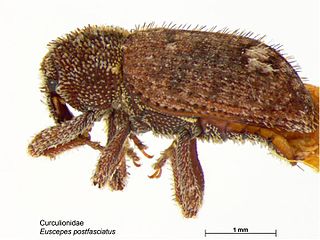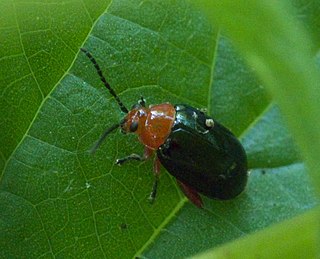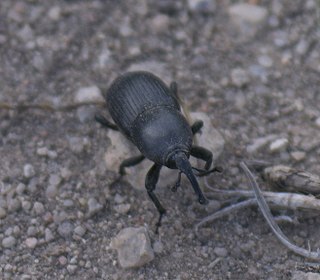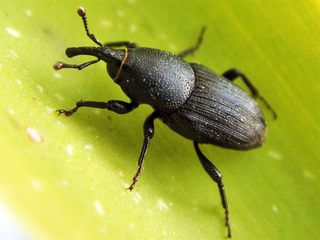
The flea beetle is a small, jumping beetle of the leaf beetle family (Chrysomelidae), that makes up the tribe Alticini which is part of the subfamily Galerucinae. Historically the flea beetles were classified as their own subfamily.

Erectopus is an extinct genus of basal allosauroid theropod from the Early Cretaceous La Penthiève Beds Formation of France and also possibly the Cernavodă Formation of southern Romania. The type species is E. superbus, which was initially known as a species of Megalosaurus.

Apenes is a genus of ground beetles in the family Carabidae. There are at least 80 described species in Apenes.

Bromius obscurus, the western grape rootworm, is a species of beetle in the leaf beetle family. It is the only member of the genus Bromius. The distribution of the species is holarctic; it can be found in North America, wide parts of Europe, and Asia. The species is a known pest of grape vines in Europe and western North America.

Sphenophorus is a genus of weevils, often known as billbugs, in the family Curculionidae, and tribe Sphenophorini. Eleven species of billbugs infest managed turfgrass in North America.

Exophthalmus is a genus of broad-nosed weevils in the family Curculionidae. It contains 85 described species.

Enoclerus is a genus of checkered beetles in the subfamily Clerinae.

Euscepes is a genus of hidden snout weevils in the family Curculionidae. There are at least 20 described species in Euscepes.

Lepyrus is a genus of true weevils in the beetle family Curculionidae. There are more than 70 described species in Lepyrus.

Asphaera is a genus of flea beetles in the family Chrysomelidae, containing some 130 species, found in North America, Central America, and the Neotropics.
Orthognathus is a genus of snout and bark beetles in the family Dryophthoridae. There are about seven described species in Orthognathus.

Scyphophorus is a genus of snout and bark beetles in the family Dryophthoridae. There are about 11 described species in Scyphophorus.

The Sphenophorini are an important tribe of weevils in the subfamily Dryophthorinae; however, BioLib places this taxon at the subtribe level.
Diocalandra is a genus of weevils in the subfamily Dryophthorinae and the monotypic tribe Diocalandrini. Species are distributed mostly in Africa, Asia and Australia and includes the lesser or four-spotted coconut weevil.

Cryptoderma is a genus of weevils in the subfamily Dryophthorinae and the monotypic tribe Cryptodermatini. Species records currently appear to be limited to eastern Asia.

Cactophagus is a genus of snout and bark beetles in the family Dryophthoridae found in Central America, southern North America, and northern South America. There are more than 50 described species in Cactophagus.

Blepharida is a genus of leaf beetles of the subfamily Galerucinae. They have co-evolved with plants in the genus Bursera, which they feed on. The plants have developed a sticky, poisonous resin that sprays out when the leaves are bitten into, and the beetles have evolved to cut through the veins of the leaves to disable this mechanism first. There are currently 73 known species in Blepharida, which are found in the Nearctic, Neotropical, Afrotropical and southern Palearctic realms.















